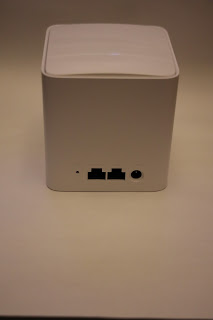Tenda is Chinese company that specialise in networking products for home and office. They have been making WiFi MESH products for a while under their NOVA brand and have released the NOVA MW5C
In the box there are 3 WiFi MESH units, 3 USB power supplies and one Ethernet/LAN cable. All the units are identical and plugging one in and connecting to the network, then makes it the primary unit. Only one unit should be plugged in while configuring. Each unit is 91 x 91 x 93 mm and are white with an LED in front which shows the status of the device (green operating correctly) and 2 Ethernet ports (WAN/LAN) each port supports 1Gb/s speed.
In order to configure the units, the Tenda app must be dowloaded (available on iOS and Android, it would be nice if there was a desktop version). Turn on WiFi and scan for the network that starts with NOVA (NOVA_XXXX), connect and then the app will allow configuration. The first thing is setting the wireless settings (i.e. SSID and password) and then reconnecting to the new setting, the device is given a location which will be visible on the home screen. It's possible to setup the system to be a full blown router and it can connect to a Ethernet modem using PPPoE. However, most people will probably just use bridge mode which just means the unit will bridge the WiFi to the wired network and that's pretty much all the configuration required (it will use DHCP to get an IP address/router/etc). There are 2 x 10/100/1000Mb/s Ethernet ports, WAN and LAN. The WAN port should be connected to the WAN side of the network (or the network connected to the main router) and the LAN port can be connected via a switch to local devices.
The WiFi supports 802.11 a/ac/n at 5GHz supporting 867Mb/s and 2.4GHz 802.11b/g/n 300Mb/s and MU-MIMO with beamforming.
Once the initial unit is configured and working then plug in the other units and they will automagically connect to the mesh and be visible in the app (and the user just needs to assign a location). That's it, the mesh units require no configuration at all which is a major plus.
In the app the main screen shows the condition of the units and if they are meshing and the number of connected devices. At the top left of the screen there's a 'figure' where you set-up a Tenda account and on the right the WiFi network.
The bottom shows My WiFi (which is the initial entry screen)
The up and down bandwidth settings are zero as the unit is in bridge mode, if PPoE or other mode were used, they would display the settings from the connected modem.
Settings in which there are the following sections:
Internet Settings sets the mode of the system, Bridge is easiest as that just bridges the WAN to LAN side, though it can be used to work with PPPoE, Dynamic IP, Static IP.
Add nova allows adding of more mesh units.
Fast Roaming allows devices to switch between the nova units using Tenda's proprietary protocol but it doesn't support older devices (such as pre iOS 5).
Capacity-oriented Mode allows more than 30 devices to work reliably.
Smart Assistant switches the system to 2.4GHz only allowing the system to scan for devices that can only connect on 2.4GHz.
Date & Time is just that.
Firmware update will check to see if all the units are on the latest firmware and if not offer to upgrade them.
Maintenance Schedule sets a time when the systems will reboot, can be set at a specific time on any day (Monday through Sunday).
Account Authorization allows adding another account that can manage the system.
Three NOVA MESH units should cover around 3500 square feet (300 m²).
The 3 system unit can be found for around £100 from your local on-line retailer, which is pretty good value for reliable WiFi around your home or home office audit really does just work. devices like Google's NEST and Amazon Echo's happily connect and the connection is a lot stabler than an older router that was handling all the WiFi previously.
It is a shame there's no desktop app and also that the system only meshes over radio when some locations will have Ethernet locally to more than one node and a major disadvantage is it only supports WPA/WPA2-PSK which Apple devices report as weak security. It's also slightly odd that there's a maintenance schedule where the units will reboot (though that can be turned off by just not ticking any days or time), modern day devices shouldn't need to reboot at all.




